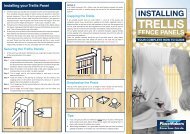SKILLS MAINTENANCE REVIEW DEFINES FOUR ... - PlaceMakers
SKILLS MAINTENANCE REVIEW DEFINES FOUR ... - PlaceMakers
SKILLS MAINTENANCE REVIEW DEFINES FOUR ... - PlaceMakers
Create successful ePaper yourself
Turn your PDF publications into a flip-book with our unique Google optimized e-Paper software.
The more often the person is exposed,the worse the dermatitis becomes.Those affected may have to leave theindustry, if the condition becomes serious.The symptoms of dermatitis usually showwithin 24-48 hours of cement exposure.Overseas research shows that5%-10% of constructionworkers may be sensitised,or allergic, to cementDepending on the severity of exposure,symptoms include:• A red rash or bumps on theexposed skin.• Itching, sometimes severe.• Dry, cracked, red patchesresembling a burn.• Blisters that drain fluid orbecome crusted.• Pain, tenderness or heat onthe exposed skin.• Scaly, raw or thickened lesions.Some components or additives in thecement are classified as hazardoussubstances. This means that the cementsupplier has to provide the person incharge of the place of work with safetydata sheets. Safety data sheets containuseful information on how to keep safewhen handling the concrete, what to -doif an emergency occurs or if significanthealth reactions occur.Wet cement can cause burns, if trappedagainst the skin. Personal protectiveclothing or equipment such as glovesor boots must not allow wet cement to beheld against the skin.However, if this occurs, it is important toimmediately wash the area with soap andwater to remove cement from the skin.Wet cement trapped against the skin caused burns tothis person’s legControls for workingwith wet cement• Wear appropriate protective clothingand equipment: gloves, safety goggles(if splashes to the face could occur),long clothing, waterproof footwear.• Remove footwear/clothing immediatelyand wash skin with a pH-neutral soap andwater if direct contact with concrete occurs.• If the symptoms of dermatitis appear, seea doctor as soon as possible for treatment.About this guidanceThis is an excerpt fromMBIE’s Concrete PumpingHealth and Safety Guidelines,which provides practicaladvice about the safe operation andmaintenance of concrete pumpingequipment. The emphasis is to ensurea safe working environment wheneverthis equipment is used. They are notintended to be an all-encompassingdesign, maintenance and operationmanual. This information is availablein manufacturers’ operating manuals.This document is based on thecurrent knowledge of constructionmethods within the industry, and is notintended to exclude other methods orprocesses that can be shown to meetthe requirements of providing a safeworkplace under the Act.The guidelines were prepared bya committee of representatives fromthe Concrete Pumping Associationof New Zealand (CPANZ) andunderwent a public consultationprocess. This resulted in submissionsfrom a range of affected parties,including the self-employed,employers and employees within theindustry.Consultation with the Ministry ofBusiness, Innovation and Employmentensured overall compatibility withoccupational health and safetylegislation and technical alignmentwith standards.Tick the correct answers below and record what you’ve learnt! Evidence of actual learning rather than just ‘participation’ is becominga key requirement of the LBP renewal process.16) a b c17) a b c18) a b cWhat can increase the risk of injuryduring set-up?a) If the terrain or access to the work areais covered with obstacles and debris.b) If there’s an air blockage in the hose.c) An attack by flesh-eating zombiesfrom Mars.Why can clearing blockages in pipelinesbe a highly hazardous task?a) Their removal may release built-up airpressure.b) There’s a risk of piles and noxious gasesc) Their removal may release hardenedconcrete.What can happen if skin comes intocontact with wet cement?a) Your handprint being immortalised onyour customer’s driveway.b) Burns and/or dermatitis.c) Builder’s foot.NB: The questions and answers in this section have been produced by the publisher and do not necessarily reflect views or opinions of the contributing organisation.23
















